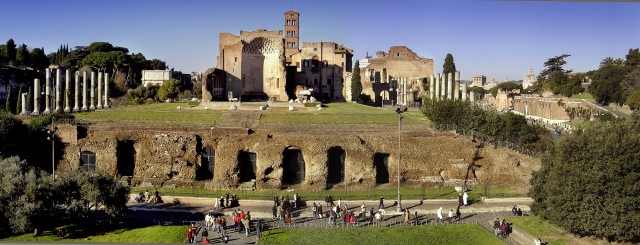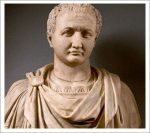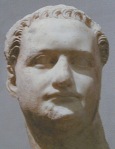Roman Emperor and wise philosopher king Marcus Aurelius made what turned out to be a very bad decision before his death in 180. He named his son Commodus as his successor. Throughout the entire second century, Rome had experienced long periods of relative peace and prosperity under the 5 good emperors, all of whom where adoptive heirs chosen for their wisdom and ability to rule. It had been over 100 years since the last father/son succession (Titus and Vespasian in AD 79). The decision to make Commodus emperor had long reaching consequences. Many scholars mark his reign as the beginning of the end of the Roman empire.
 Commodus was the first emperor who was born during the reign of his emperor father. He was only 18 when he took the throne. Almost immediately, he took a hands-off approach to governing, leaving the daily grind of politics and decision making to his advisors so that he could do whatever else he wanted. I remember seeing the movie “Gladiator” in 2000 when it came out, which depicts Jauquin Phoenix as Commodus. When I saw the movie, I was pretty turned off by how loose the history was for a historical epic. After doing a little research, I was shocked to find out that while the history of the movie is poor and 95% fabricated for storytelling, the craziest of Commodus’ behaviors are well documented. He was a monster who thought of himself as a god (just look at this portrait bust picture here of Commodus as Hercules), and he was obsessed with gladiatorial games and indeed loved nothing more than fighting in front of assembled Rome. Of course, he always won and even killed slaves as a warm up activity. Winning in the arena didn’t make him a hero to the people however… To the Romans, gladiators were among the lowest of the low, so it deeply offended the senators and citizens of Rome to see the emperor stoop to their level. On top of that, he required people to come to the arena and charged them money to see him fight. Commodus survived a few assassination attempts, and became increasingly paranoid. In his madness, he renamed the months of the year for himself, demanded to be addressed as “Hercules son of Zeus” and wore a lion skin and carried a club on public occasions. On one occasion, he killed 3 elephants, a giraffe and a tiger in the ring. He also cut the head off of an ostrich, walked up into the seats and held the head over the senators, implying that he could kill them too as he had the ostrich. In 191, another fire destroyed large parts of Rome, including the sacred temple of Vesta and the temple of peace. It was seen as a bad sign to all of Rome, except for Commodus, who saw it as an opportunity to promote himself as the second founder of Rome. He went so far as to re-name Rome after himself. Not surprisingly, he was eventually murdered in an elaborate plot. After 12 years, his reign was done and once again, Rome was plunged into a near civil war over who should succeed.
Commodus was the first emperor who was born during the reign of his emperor father. He was only 18 when he took the throne. Almost immediately, he took a hands-off approach to governing, leaving the daily grind of politics and decision making to his advisors so that he could do whatever else he wanted. I remember seeing the movie “Gladiator” in 2000 when it came out, which depicts Jauquin Phoenix as Commodus. When I saw the movie, I was pretty turned off by how loose the history was for a historical epic. After doing a little research, I was shocked to find out that while the history of the movie is poor and 95% fabricated for storytelling, the craziest of Commodus’ behaviors are well documented. He was a monster who thought of himself as a god (just look at this portrait bust picture here of Commodus as Hercules), and he was obsessed with gladiatorial games and indeed loved nothing more than fighting in front of assembled Rome. Of course, he always won and even killed slaves as a warm up activity. Winning in the arena didn’t make him a hero to the people however… To the Romans, gladiators were among the lowest of the low, so it deeply offended the senators and citizens of Rome to see the emperor stoop to their level. On top of that, he required people to come to the arena and charged them money to see him fight. Commodus survived a few assassination attempts, and became increasingly paranoid. In his madness, he renamed the months of the year for himself, demanded to be addressed as “Hercules son of Zeus” and wore a lion skin and carried a club on public occasions. On one occasion, he killed 3 elephants, a giraffe and a tiger in the ring. He also cut the head off of an ostrich, walked up into the seats and held the head over the senators, implying that he could kill them too as he had the ostrich. In 191, another fire destroyed large parts of Rome, including the sacred temple of Vesta and the temple of peace. It was seen as a bad sign to all of Rome, except for Commodus, who saw it as an opportunity to promote himself as the second founder of Rome. He went so far as to re-name Rome after himself. Not surprisingly, he was eventually murdered in an elaborate plot. After 12 years, his reign was done and once again, Rome was plunged into a near civil war over who should succeed.
 The year 193 was a rough one for Rome. As in the year 68-69 when Nero’s death sent Rome into chaos and 4 emperors ruled in one years time, Rome again was plunged into uncertainty and bloodshed. As with Nero, the problem was that there was no heir for Commodus. There was a quick move to install a man named Pertinax as emperor. By all accounts, he was a solid candidate as a respected military general and former senator. He only reigned 3 months before he was assassinated by rivals with other ideas. 3 Roman generals were all proclaimed emperor by troops who supported them, and after long peroids of battle between romans, Septimus Severus was emperor. He was ruthless in claiming power. He had the supporters of his rivals killed, including 27 senators. He raised the yearly pay for soldiers, securing their support, even has he waged brutal war in modern day Iraq. He was victorious, and continued to strengthen the military might of the empire. He took to rebuilding much of what was destroyed in the fire of 191 under Commodus. Here’s what the ancient history says of Septimus Severus:
The year 193 was a rough one for Rome. As in the year 68-69 when Nero’s death sent Rome into chaos and 4 emperors ruled in one years time, Rome again was plunged into uncertainty and bloodshed. As with Nero, the problem was that there was no heir for Commodus. There was a quick move to install a man named Pertinax as emperor. By all accounts, he was a solid candidate as a respected military general and former senator. He only reigned 3 months before he was assassinated by rivals with other ideas. 3 Roman generals were all proclaimed emperor by troops who supported them, and after long peroids of battle between romans, Septimus Severus was emperor. He was ruthless in claiming power. He had the supporters of his rivals killed, including 27 senators. He raised the yearly pay for soldiers, securing their support, even has he waged brutal war in modern day Iraq. He was victorious, and continued to strengthen the military might of the empire. He took to rebuilding much of what was destroyed in the fire of 191 under Commodus. Here’s what the ancient history says of Septimus Severus:
“He restored a very large number of the ancient buildings and inscribed them with his name, just as if he had erected them in the first place from his own private funds. He also spent a great deal uselessly in repairing other buildings, and in constructing new ones.”
Today, you can see the ruins of these many building projects. The largest is in the forum, the large arch of Septimus Severus that still stands in amazing condition and serves as a gateway into the city center. It was built to commemorate the victories in the Parthian wars in 203. Relief carvings and inscriptions on the arch are still visible. He also built a huge addition to the imperial palaces on the Palatine Hill, which included bumping out the hill to overlook the Circus Maximus. Today the ruins are clearly visible at the palace complex. Septimus Severus ruled for 18 years before he died of illness. In his statues, he is made to look a lot like Marcus Aurelius and Antoninus Pius with his regal beard. Those emperors, he was not, but he did succeed in accomplishing much through the use of ruthless power. He learned nothing from history, because he named his sons co-emperors as his successors, saying to them on his death bed, “Be generous to the soldiers, and take no head of anyone else!”.
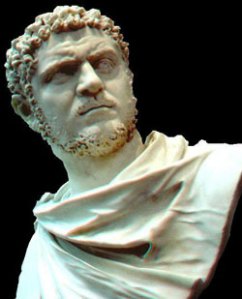 His sons were Caracalla and Geta, and the only problem was that they hated each other. Caracalla murdered his own brother within 10 months, becoming sole emperor. It was a bad PR move, but Caracalla took his fathers dying advice. He went directly to the soldiers, claimed that he killed his brother in self-defence, and then gave them an even bigger pay raise. With the army behind him, he set about eliminating all of Geta’s many supporters. In the early months of 212, as many as 20,000 people were killed in mass executions. Some courageous romans protested, and they were killed too. It sounds stupid to say it, but Caracalla wasn’t crazy (as Commodus and Caligula were), but rather insanely paranoid and ruthless. He was willing to do anything to have his way and maintain power.
His sons were Caracalla and Geta, and the only problem was that they hated each other. Caracalla murdered his own brother within 10 months, becoming sole emperor. It was a bad PR move, but Caracalla took his fathers dying advice. He went directly to the soldiers, claimed that he killed his brother in self-defence, and then gave them an even bigger pay raise. With the army behind him, he set about eliminating all of Geta’s many supporters. In the early months of 212, as many as 20,000 people were killed in mass executions. Some courageous romans protested, and they were killed too. It sounds stupid to say it, but Caracalla wasn’t crazy (as Commodus and Caligula were), but rather insanely paranoid and ruthless. He was willing to do anything to have his way and maintain power. 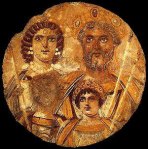 The names and likeness of Caracalla and Geta were everywhere on the buildings built by his father Septimus Severus. Caracalla had all references to Geta removed. Just look at this image here, a fresco of Septimus Severus and his family. You can clearly see one of the boy’s faces completely scratched away.
The names and likeness of Caracalla and Geta were everywhere on the buildings built by his father Septimus Severus. Caracalla had all references to Geta removed. Just look at this image here, a fresco of Septimus Severus and his family. You can clearly see one of the boy’s faces completely scratched away.
Caracalla was too paranoid to stay in Rome where it was only a matter of time before he would be assassinated. He spent most of his 6 years as emperor on the battlefront with the army, waging war in Germany and in the west. He had raised soldiers salaries 50%, so he had protection- or so he thought. He was killed by one of his own bodyguards as he went to relieve himself in the woods. A glamourous way to go for a glamourous guy.
Even though he stands with the most tyrannical of emperors, Caracalla’s name marks one of the greatest Roman structures. Most likely begun by his father and completed by Caracalla, an enormous roman bath complex is among the most impressive ruins in all of Rome. To the Romans, visiting the baths was a way of life, both a cleansing ritual and a part of social society. Caracalla’s baths were one of the largest structures ever, originally decked out from floor to ceiling with precious marble and bronze, paintings and sculptures. Of course, those are all long-gone, as is the roof. Still, the shear size of the baths is mighty impressive. More to come on the baths in a later post-

















